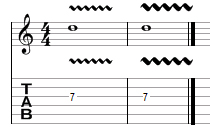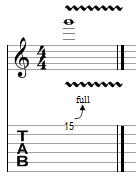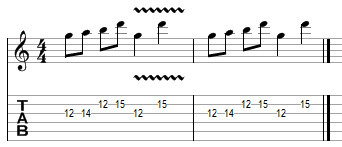Vibrato is Italian meaning tremble or quiver. If you’ve ever listened to an opera singer or a singing diva you would have heard a lot of vibrato in their voices. Have you noticed how often they hold a note and make it wobble? That’s vibrato. Like with singing, vibrato is used to inject some emotion and soul into a note. We shake and wobble some life into it. Almost all forms of music feature vibrato, blues, classical, jazz, rock and metal. Without vibrato you’ll lose that human touch and your music may become robotic and souless.
First let’s have a look how vibrato looks in tablature.

That squiggly line above the note tells us to add some vibrato. In the second bar we can see a bigger, fatter squiggly line. That’s telling us to play a wide big fat vibrato. Listen to the example and you should be able to hear the difference between the two.
So how exactly do we play vibrato?
Simply all we have to do is shake the note up and down quickly. Think of them as lots of fast mini bends. Play the note as you would normally, then rub the note up and down along the fret.
How fast, and how much should we shake the note?
This is the million dollar question that is entirely up to you. Generally speaking, for normal vibrato aim to bend and shake the note a small amount, Less than a semi-tone. For a wide vibrato some players will shake the note up to a whole tone up and down.
As for how fast you should be playing your vibrato, that’s up to you to decide what sounds good. Some players will play a fast or slow vibrato depending on how fast the song is they’re playing. Some players will play a slow vibrato for a romantic ballad, and a really rapid vibrato for a aggressive metal song. Some guitarists may use the same speed vibrato for everything they play.
A guitarists vibrato is a bit like a finger print. It’s unique to you, and listeners with sharp ears can even recognise a guitarist just from his/her vibrato. Depending on your vibrato some listeners may decided you’re amazing, or they my decide you stink, purely on the sound of your vibrato!
Obviously it’s all subjective. One listener my decide your vibrato is terrible, and another may think it rocks. Listen to people’s opinions and be mindful of them, they may have a point and some useful tips. But at the end of the day it’s up to you how you play your vibrato.
Commonly people add vibrato to bent notes.

As you can see that squiggly line is just stuck above the bent note. The note is bent first, and then the vibrato is added once we’ve reached the top of the bend. In some instances you may like to add the vibrato during the bend as well.
Let’s look at an example to demonstrate what a difference vibrato makes.

In the first bar we’ve added vibrato to those last two notes. And in the second bar we’ve taken the vibrato out. Have a listen to the difference. The second bar should sound much more flat and robotic. Hopefully this demonstrates the value of vibrato.
Vibrato is something most musicians and singers do automatically. Anytime you have to hold a note many guitarists will automatically add vibrato without thinking. Maybe you’ve been doing this also without even realising? In some cases you might see a piece of tab and they’ve not bothered to include the vibrato squiggles. They just assume you’ll add vibrato when you need it since it’s so often used.
Good luck and have fun exploring you own unique vibrato!
- Vibrato makes notes wobble.
- This adds emotion and life to a note.
- Playing without vibrato can sound souless and robotic.
- The speed and depth of vibrato varies from guitarist to guitarist.
